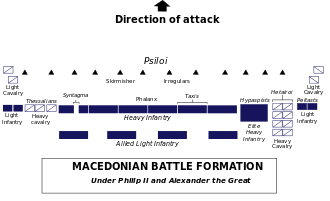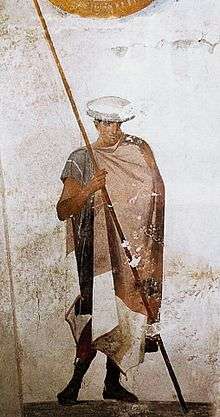Macedonian phalanx

The Macedonian phalanx is an infantry formation developed by Philip II and used by his son Alexander the Great to conquer the Achaemenid Empire and other armies. Phalanxes remained dominant on battlefields throughout the Hellenistic period, although wars had developed into more protracted operations generally involving sieges and naval combat as much as pitched battles, until they were ultimately displaced by the Roman legions.
Development

Philip II spent much of his youth as a hostage at Thebes, where he studied under the renowned general Epaminondas, whose reforms were the basis for the phalanx. Phalangites were professional soldiers, and were among the first troops ever to be drilled, thereby allowing them to execute complex maneuvers well beyond the reach of most other armies. They fought packed in a close rectangular formation, usually eight men deep, with a leader at the head of each column and a secondary leader in the middle, so that the back rows could move off to the sides if more frontage was needed.
Equipment
Each phalangite carried as his primary weapon a sarissa, a double-pointed pike over 6 m (18 ft) in length. Before a battle the sarissa were carried in two pieces and then slid together when they were being used. At close range such large weapons were of little use, but an intact phalanx could easily keep its enemies at a distance; the weapons of the first five rows of men all projected beyond the front of the formation, so that there were more spearpoints than available targets at any given time. Men in rows behind the initial five angled their spears at a 45 degree angle in an attempt to ward off arrows or other projectiles.[1] The secondary weapon was a shortsword called a kopis, which had a heavy curved section at the end.
Formation
The phalanx consisted of a line-up of several battalion blocks called syntagmata, each of its 16 files (lochoi) numbering 16 men, for a total of 256 in each unit. Each syntagma was commanded by a syntagmatarch, who - together with his subordinate officers - would form the first row of each block.[2]
Neither Philip nor Alexander actually used the phalanx as their arm of choice, but instead used it to hold the enemy in place while their heavy cavalry broke through their ranks. The Macedonian cavalry fought in wedge formation and was almost always stationed on the far right; after these broke through the enemy lines they were followed by the hypaspists, elite infantrymen who served as the king's bodyguard, and then the phalanx proper. The left flank was generally covered by allied cavalry supplied by the Thessalians, which fought in rhomboid formation and served mainly in a defensive role. Other forces—skirmishers, range troops, reserves of allied hoplites, archers, and artillery—were also employed.
References
- ↑ Polybius. The Histories. Chapters 28–32. Retrieved 14 September 2014.
- ↑ Connolly, Peter: The Greek Armies, pp. 58-59: "The Macedonian Phalanx". MacDonald & Co. Ltd, London, 1982. ISBN 0 356 05580 9.